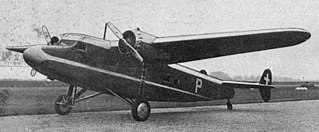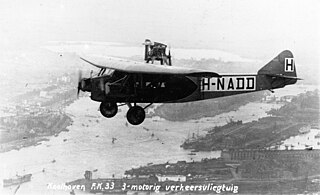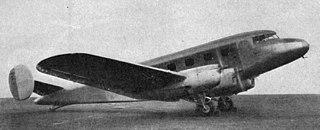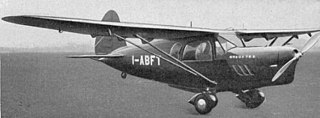
Auster Aircraft Limited was a British aircraft manufacturer from 1938 to 1961.

N.V. Koolhoven was an aircraft manufacturer based in Rotterdam, Netherlands. From its conception in 1926 to its destruction in the Blitzkrieg in May 1940, the company remained the second major Dutch aircraft manufacturer. Although many of its aircraft were as unsuccessful economically as they were brilliant from a design standpoint, the company managed to score several 'hits', amongst them the FK-58 single-seat monoplane fighter, the FK-50 twin-engine passenger transport, and the FK-41, built in England under licence by Desoutter.

The de Havilland DH.60 Moth is a 1920s British two-seat touring and training aircraft that was developed into a series of aircraft by the de Havilland Aircraft Company.

The Miles M.2 Hawk was a twin-seat light monoplane designed and produced by the British aircraft manufacturer Miles Aircraft Limited during the 1930s. It is the first of the company's aircraft to attain quantity production.

The Koolhoven F.K.50 was a 1930s Dutch eight-passenger light transport monoplane designed and built by Koolhoven.

The NVI F.K.33 was an airliner built in the Netherlands in 1925 for use by KLM for night flying.

The Koolhoven F.K.48 was an airliner built in the Netherlands in 1934 for KLM.

The de Havilland DH.81 Swallow Moth was aimed at the low-cost sporting aircraft market during the Great Depression. It was a single-engined two-seat low-wing monoplane; only one was built.

The Potez 661 was a four-engined metal low-wing monoplane airliner developed in France just before World War II. The single example flew with Air Afrique on French colonial routes.

The Breda Ba.79S was a single-engine four-seat high-wing private aircraft built in Italy in the late 1930s. Only a few were produced.

The CANT Z.1012 was a small three-engined monoplane built in Italy in the late 1930s to carry either three or five passengers depending on the engines. A small number were built for Italian diplomatic use.

The Carden-Baynes Bee was a 1930s British two-seat aircraft, with twin engines in pusher configuration buried in the wings. The wings rotated for storage. Financial problems limited the Bee to a single flight.

The Praga E-210 was a four-seat, twin-engined touring aircraft built in Czechoslovakia in the late 1930s. It had an unusual pusher configuration. Its tail unit and undercarriage were modified significantly before World War II and after the war a more powerful version designated E-211 was flown.

The Gwinn Aircar was a single-engined biplane with a cabin for two, designed in the US as a safe and simple private aircraft. Lacking a rudder, it had several unusual control features as well as an early tricycle undercarriage. Development was abandoned after a crash in 1938.

The Morane-Saulnier MS.341 was a single engine parasol wing training and touring aircraft built in France in the mid-1930s. It had two open cockpits in tandem and was sold to private owners, clubs and the Armée de l'Air.

The SAIMAN LB.2 was an unconventional Italian two seat cabin side by side sport aircraft designed around 1937, with a single pusher configuration engine, twin tail booms and an early tricycle undercarriage.

The Koolhoven F.K.47 was a 1930s one-off two seat biplane designed and built in the Netherlands for an individual customer as a sport and touring aircraft.

The Koolhoven F.K.54 was a Dutch single-engine, three-seat touring aircraft with a retractable undercarriage. It flew shortly before the start of World War II and its development was abandoned after its first flight as attention turned to military aircraft.

The NVI F.K.34 was a three-seat reconnaissance floatplane built in the Netherlands in 1925 as a private venture in the hope of a Dutch Naval Aviation Service order; two accidents during testing meant that it did not go into production.

The NVI F.K.35 or Koolhoven F.K.35 was a two-seat fighter aircraft built in the Netherlands during 1926. It was completed and exhibited but, through a combination of ground accident and financial problems, never flown.




















